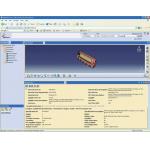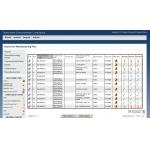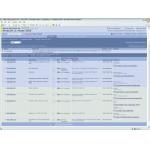Latest News
February 1, 2006
By Louise Elliott
This second of two articles discusses the existing PLM tools available to companies facing new regulations on products for distribution in European and Asian countries. Click here for Part One.—DE
If PLM vendors agree on a single unifying theme regarding environmental regulatory compliance, it is that compliance must begin at the design stage of product development. They also concur that PLM is the logical place to make that happen. However, they differ in the ways their systems address the issue.
Design Requirements
“The trend is to make compliance occur inside the purview of the designer,” says Mike Adams-Sampson, vice president of product strategy for MatrixOne. PLM treats the engineering process from the requirements viewpoint, he points out. Requirements form the basis of product design and compliance can be guaranteed if the regulations become requirements at the front end.
|
|
| Dassault Systemes’ ENOVIA enterprise component management capabilities are shown above. Detailed specifications, which could include RoHS-specific information, will be available within the ENOVIA portal as component properties. |
In the past, says Adams-Sampson, “the average designer just had to know the performance data about materials. Now he needs to know their contents and where they’re allowed to be sold.”
To provide that information to designers, MatrixOne can create a Bill of Substances along with a mechanism for rolling up substance quantities, and it offers ways to handle that data within the threshold levels stipulated in such regulations as End-of-Life vehicles (ELV), Waste Electrical and Electronic Equipment (WEEE), and Recycling of Hazardous Substances (RoHS). The functionalities apply both to in-house components and those from outside suppliers, and include tools for suppliers to enter their substance data.
“The software works with chemical abstract numbers for defining the substances, and allows companies to input the amounts, based upon the regulations,” says Adams-Sampson. “It also has reporting tools for viewing the product content and how it complies.”
Compliance Engine
Agile Corp. offers Product Governance & Compliance (PG&C), which covers tracking and reporting for all regulations: financial, environmental, and FDA. “We extended PLM to manage material restrictions,” says Ray Hein, vice president of product strategy for Agile. “The materials covered in the RoHS regulations are used heavily in electronics, and many companies now are using those regulations as a standard for manufacturing new products.”
The company released PG&C about a year and half ago. “One of our greatest strengths,” says Hein, “has always been in developing bills of material (BOMs), and the new capability provides a BOM with hazardous substances broken out in parts per million.”
Hein says that the module understands the composition of the materials used in product development, and can analyze a product BOM for hazardous substances, evaluate the data against the regulations, and report on compliance. It has a functionality enabling a filter for viewing all environmental regulations worldwide and running them against product BOMs. “The manufacturer can see if the product is compliant at all levels—and it will work for suppliers as well if they can access other Agile tools,” Hein adds.
Tracking Many Data Requirements
“An MCAD user starts his design process for, say, the chassis of a laptop computer by searching for parts,” says Chad Hawkinson, director of high tech marketing strategies for PTC. “Now he not only needs to know whether the part works as required, but also does it comply with regulations, have the right lead time, cost, lifespan that will be as long as that of the computer, and also, how it can be disposed of.”
Windchill provides a solution at the design level, Hawkinson says. “Companies use it to connect engineering with the rest of the organization—because it gives enterprise access to design and compliance data, making it available to manufacturing, procurement, support, suppliers, and manufacturing partners as well as designers.”
He says that PTC has kept in mind user requests for a place to store compliance data; a way to meet their needs for applying that data to product structures and separating compliant from non-compliant parts; designer interaction with compliance data; and documentation for all the different languages, formats, and due-diligence requirements.
Hawkinson says that Arbortext, acquired by PTC this past summer, solves reporting problems. “It’s a publishing system that can repurpose Windchill data in different formats for different countries—and users only have to translate the data once.”
Strategy, Design, and Manufacturing
“Anyone comparing design requirements and compliance requirements will find that the two differ depending on the market,” says Tom Maurer, UGS’ director of industry marketing for high tech and electronics. “Many people want to comply with the most stringent regulations around, so that they can sell everywhere. That means they need requirements traceability, including verification of BOMs.”
|
|
| UGS’s Teamcenter enables use of a compliance engine that gives designers the ability to search parts and get a corresponding list of their material status. |
Obsolescence is an issue for high-tech component manufacturers. “They need to consider end of life and build that into their product structure to manage regulatory qualification. For example, retirement of components with tin-lead leads needs to be planned, and those components replaced with compliant parts. Termination of such non-compliant products will also affect industries that are not yet regulated,” says Maurer.
UGS’ Teamcenter PLM can be used to create and manage the product structure, handle new part requests—including those for compliant parts—and incorporate vendor material declarations in a compliance engine. “The data model goes deep and includes material and substances,” says Maurer. Teamcenter provides information that helps engineers design with end of life in mind. “Short-term solutions may get companies through the July 2006 RoHS deadline, but not much further.”
Manufacturing also needs to consider compliance issues, and Maurer notes that UGS’ Tecnomatix, which can identify products for lead-free manufacturing, also has a system that divides product lines so that those being sold into regulated markets will comply.
Compliance On Demand
“In designing for the environment, mid-market companies need to be able to handle many of the same compliance issues as large enterprises, and Arena Solutions can help them reduce their risk of non-compliance because the system is very scalable,” says Eric Larkin, CTO and co-founder of Arena.
The system aims to provide full requirements management capabilities, and has started with regulatory compliance. “It enables a compliance BOM, and makes it possible to track what the company does about compliance—with a model that stipulates the requirement, its status, rationale, and evidence. After tracking, the system can generate reports to support compliance claims,” Larkin says.
|
|
| With Arena, users can create a compliance BOM that makes it possible to track what the company does about compliance, stipulating the requirement, its status, rationale, and evidence. |
He points out that regulatory compliance ultimately affects the whole product, and needs to be applied across the entire value chain; including suppliers that can’t afford or justify enterprise-level PLM systems. “Arena makes it possible for companies that supply a number of different OEMs to see data from all of them—with full access control for security—in one place. It provides an infrastructure for a community of suppliers who know how to use the tools.”
Sourcing Tools for Compliance
Breaking ranks somewhat with the other PLM spokesmen, Fabien Fedida, strategies director for Dassault Systemes, believes that because PLM deals with products and designs, not usually with supplier, component manufacturer, sourcing, or geographic data, PLM has shortcomings related to regulatory compliance. “PLM does make it easier to choose compliant parts,” he says, “so we found it was necessary to bridge the world of design and component management to bring in the data not usually stored in the PLM core.”
Dassault joined with i2 to embed i2’s core sourcing components into Dassault’s ENOVIA PLM and thus enable design engineers to access component management with RoHS and other environmental regulation data by country. “It lets designers optimize their designs by reducing the amounts of hazardous materials. They can enter the attributes of non-compliant materials and filter them out of manufacturing at the design stage—using any sourcing or material attributes they choose.”
Fedida says that having access to sourcing data simplifies the hard job of tracking manufacturers in different locations that may or may not have the required material content. “The partnership with i2 provides a cross-functional catalog of parts and sourcing for compliant materials, approved manufacturers, and vendors.”
One way or another, manufacturers that want to sell their products in the EU have to prove that they comply with RoHS by July, and with the final collection and recycling provisions of WEEE by the end of 2006. Judging by the companies quoted here, many tools are available to help them do so.
Contributing Editor Louise Elliott is a freelance writer based in California. Offer Louise your feedback on this article by clicking here. Please reference “Compliance 2, February 2006” in your message.
Company Information
Agile Corp.
San Jose, CA
Arena Solutions, Inc.
Menlo Park, CA
Dassault Systemes
Paris, France
MatrixOne
Westford, MA
PTC
Needham, MA
UGS Corp.
Plano, TX
Subscribe to our FREE magazine, FREE email newsletters or both!
Latest News
About the Author
DE’s editors contribute news and new product announcements to Digital Engineering.
Press releases may be sent to them via [email protected].









